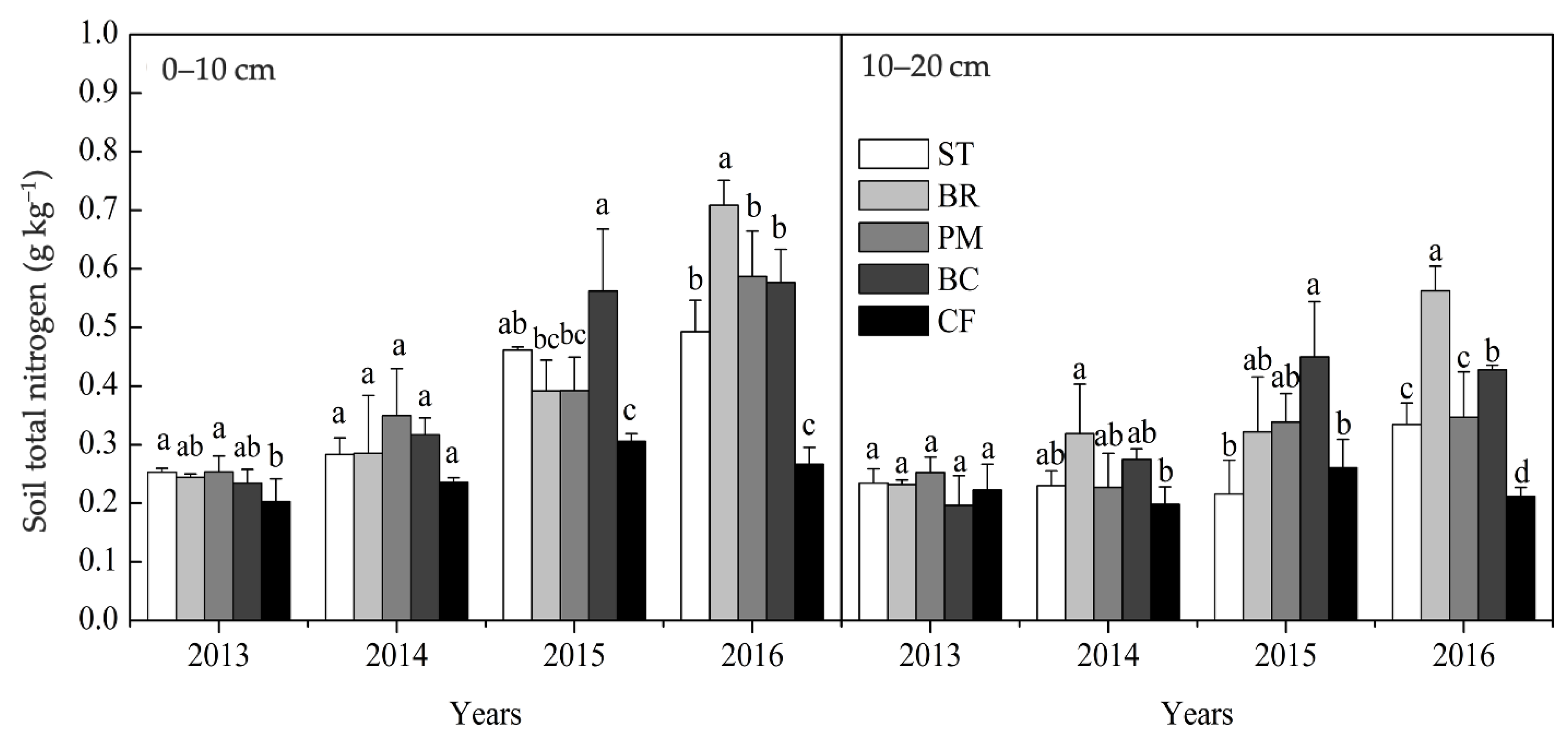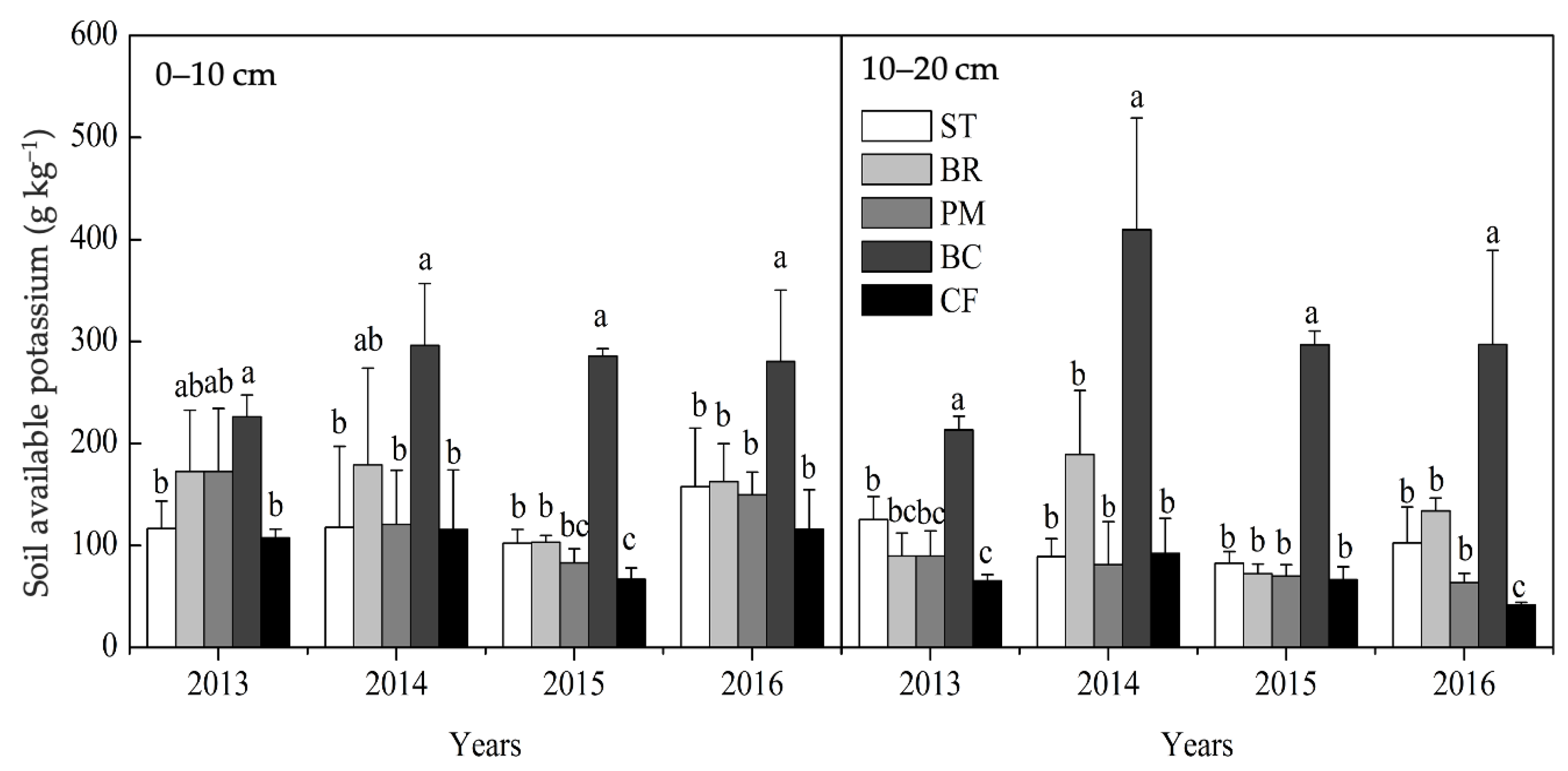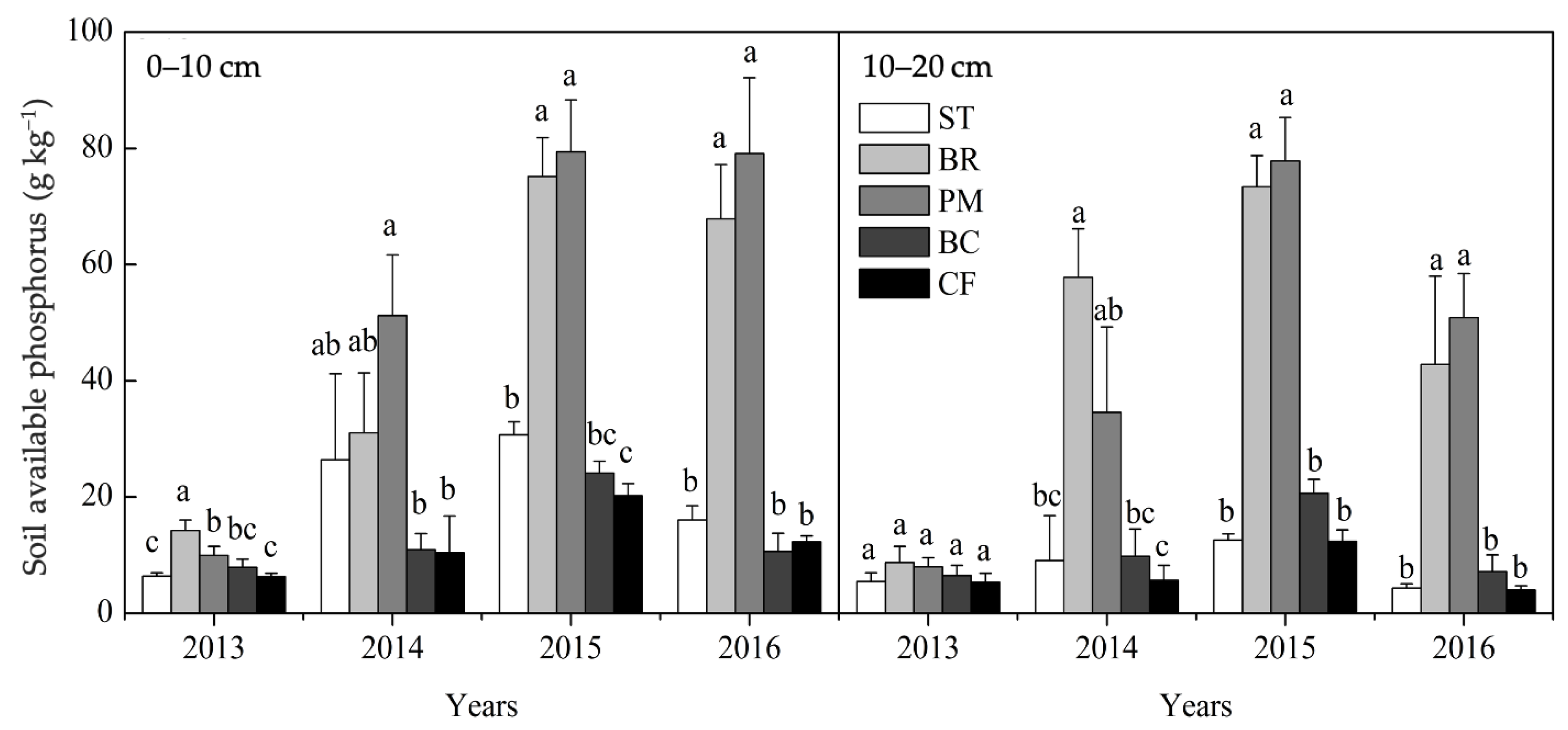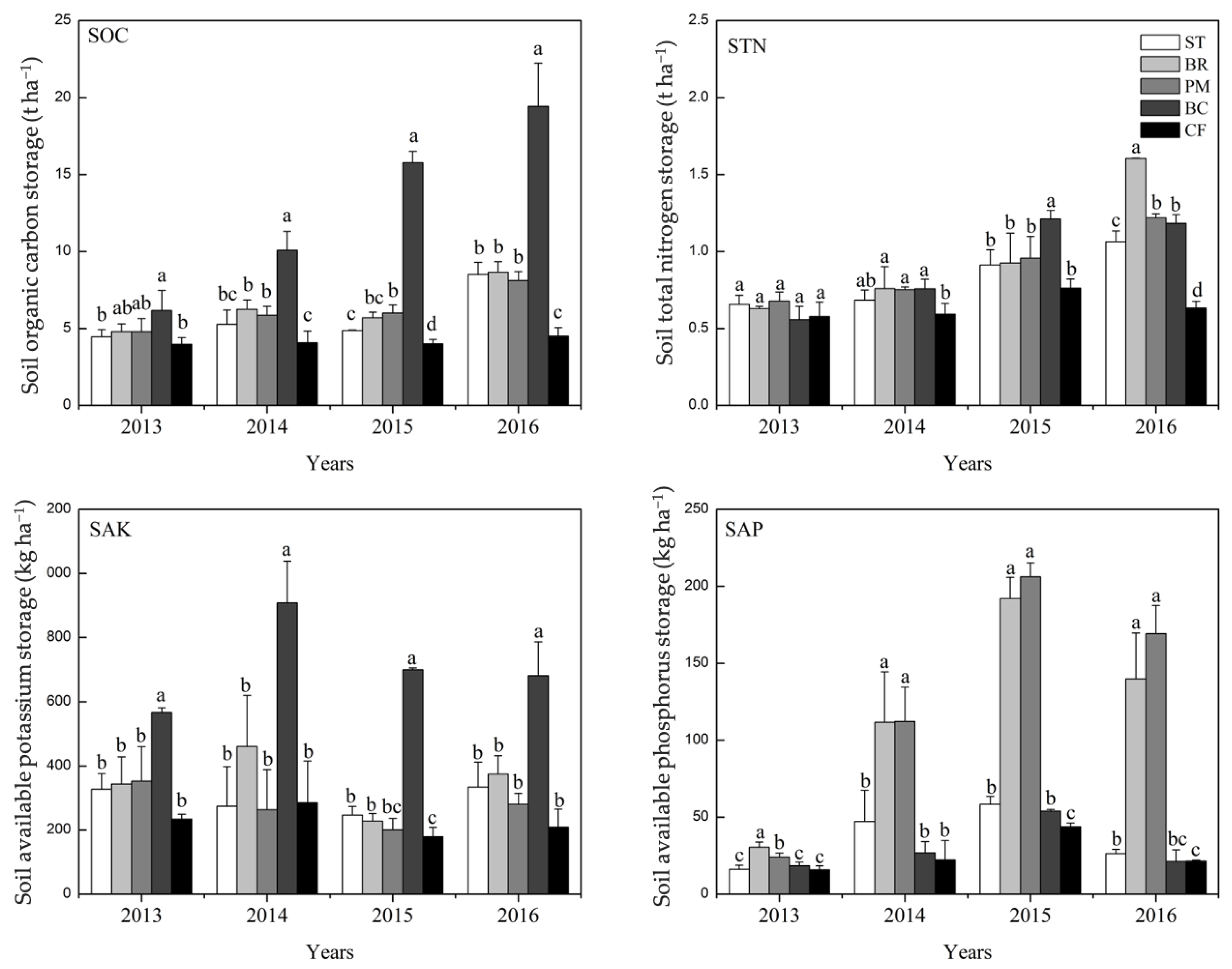Effects of Organic Amendments on the Improvement of Soil Nutrients and Crop Yield in Sandy Soils during a 4-Year Field Experiment in Huang-Huai-Hai Plain, Northern China
Abstract
:1. Introduction
2. Materials and Methods
2.1. Site Description, Climate, and Soil
2.2. Experimental Design
2.3. Soil Sampling and Analysis
2.4. Statistical Analysis
3. Results
3.1. Soil Organic Carbon
3.2. Soil Total Nitrogen
3.3. Soil Available Potassium
3.4. Soil Available Phosphorus
3.5. Effects of Organic Amendment Application on Nutrient Storage
3.6. Effects of Organic Amendment Application on Yield
4. Discussion
4.1. Effects of Organic Amendment Application on Nutrients and Productivity
4.2. Effect of Biochar Application on Medium- and Low-Yield Alkaline Sandy Farmlands
4.3. Uncertainty and Limitations
5. Conclusions
Supplementary Materials
Author Contributions
Funding
Data Availability Statement
Acknowledgments
Conflicts of Interest
References
- Gravuer, K.; Gennet, S.; Throop, H.L. Organic amendment additions to rangelands: A meta-analysis of multiple ecosystem outcomes. Glob. Chang. Biol. 2019, 25, 1152–1170. [Google Scholar] [CrossRef] [PubMed]
- Oldfield, E.E.; Wood, S.A.; Bradford, M.A. Direct effects of soil organic matter on productivity mirror those observed with organic amendments. Plant Soil 2017, 423, 363–373. [Google Scholar] [CrossRef]
- Paustian, K.; Lehmann, J.; Ogle, S.; Reay, D.; Robertson, G.P.; Smith, P. Climate-smart soils. Nature 2016, 532, 49–57. [Google Scholar] [CrossRef] [PubMed] [Green Version]
- Diacono, M.; Montemurro, F. Long-term effects of organic amendments on soil fertility. In Sustainable Agriculture Volume 2; Springer: Dordrecht, The Netherlands, 2011; pp. 761–786. [Google Scholar]
- Carabassa, V.; Ortiz, O.; Alcaniz, J.M. Sewage sludge as an organic amendment for quarry restoration: Effects on soil and vegetation. Land Degrad. Dev. 2018, 29, 2568–2574. [Google Scholar] [CrossRef]
- Bryan, B.A.; Gao, L.; Ye, Y.; Sun, X.; Connor, J.D.; Crossman, N.D.; Stafford-Smith, M.; Wu, J.; He, C.; Yu, D.; et al. China’s response to a national land-system sustainability emergency. Nature 2018, 559, 193–204. [Google Scholar] [CrossRef]
- Foley, J.A.; Ramankutty, N.; Brauman, K.A.; Cassidy, E.S.; Gerber, J.S.; Johnston, M.; Mueller, N.D.; O’Connell, C.; Ray, D.K.; West, P.C.; et al. Solutions for a cultivated planet. Nature 2011, 478, 337–342. [Google Scholar] [CrossRef] [Green Version]
- Mueller, N.D.; Gerber, J.S.; Johnston, M.; Ray, D.K.; Ramankutty, N.; Foley, J.A. Closing yield gaps through nutrient and water management. Nature 2012, 490, 254–257. [Google Scholar] [CrossRef]
- Yan, H.; Ji, Y.; Liu, J.; Liu, F.; Hu, Y.; Kuang, W. Potential promoted productivity and spatial patterns of medium- and low-yield cropland land in China. J. Geogr. Sci. 2016, 26, 259–271. [Google Scholar] [CrossRef] [Green Version]
- Chen, L.; Hao, J.; Ai, D.; Zhu, C.; Li, M.; Yuan, L. Balanced yield increasing potential of grain and its spatial differentiation in Huang-Huai-Hai Plain. Trans. Chin. Soc. Agric. Eng. 2015, 31, 288–297. [Google Scholar]
- Magdoff, F. Agroecology; CRC Press: Boca Raton, NJ, USA, 2018; pp. 349–364. [Google Scholar]
- Dai, H.; Chen, Y.; Liu, K.; Li, Z.; Qian, X.; Zang, H.; Yang, X.; Zhao, Y.; Shen, Y.; Li, Z.; et al. Water-stable aggregates and carbon accumulation in barren sandy soil depend on organic amendment method: A three-year field study. J. Clean. Prod. 2019, 212, 393–400. [Google Scholar] [CrossRef]
- Chen, Y.; Camps-Arbestain, M.; Shen, Q.; Singh, B.; Cayuela, M.L. The long-term role of organic amendments in building soil nutrient fertility: A meta-analysis and review. Nutr. Cycl. Agroecosyst. 2018, 111, 103–125. [Google Scholar] [CrossRef]
- Maltas, A.; Kebli, H.; Oberholzer, H.R.; Weisskopf, P.; Sinaj, S. The effects of organic and mineral fertilizers on carbon sequestration, soil properties, and crop yields from a long-term field experiment under a Swiss conventional farming system. Land Degrad. Dev. 2018, 29, 926–938. [Google Scholar] [CrossRef]
- Wei, W.; Yan, Y.; Cao, J.; Christie, P.; Zhang, F.; Fan, M. Effects of combined application of organic amendments and fertilizers on crop yield and soil organic matter: An integrated analysis of long-term experiments. Agric. Ecosyst. Environ. 2016, 225, 86–92. [Google Scholar] [CrossRef] [Green Version]
- Walkley, A.; Black, I.A. An examination of the Degtjareff method for determining soil organic matter, and a proposed modification of the chromic acid titration method. Soil Sci. 1934, 37, 29–38. [Google Scholar] [CrossRef]
- Black, C.A. Methods of Soil Analysis, Part I and II; American Society Incorporation Publisher: Madison, WI, USA, 1965; pp. 770–779. [Google Scholar]
- Olsen, S.R. Estimation of Available Phosphorus in Soils by Extraction with Sodium Bicarbonate; U.S. Department of Agriculture: Washington, DC, USA, 1954; Volume 939, pp. 1–19.
- Shi, R. Soil and Agricultural Chemistry Analysis; China Agricultural Press: Beijing, China, 1976; p. 388. [Google Scholar]
- Dai, H.; Zang, H.; Zhao, Y.; Qian, X.; Liu, K.; Wang, D.; Hao, J.; Chen, Y.; Sui, P. Linking bacterial community to aggregate fractions with organic amendments in a sandy soil. Land Degrad. Dev. 2019, 30, 1828–1839. [Google Scholar] [CrossRef]
- Dai, H.; Chen, Y.; Yang, X.; Cui, J.; Sui, P. The effect of different organic materials amendment on soil bacteria communities in barren sandy loam soil. Environ. Sci. Pollut. Res. Int. 2017, 24, 24019–24028. [Google Scholar] [CrossRef] [PubMed]
- Wang, T.; Kang, F.; Cheng, X.; Han, H.; Ji, W. Soil organic carbon and total nitrogen stocks under different land uses in a hilly ecological restoration area of North China. Soil Tillage Res. 2016, 163, 176–184. [Google Scholar] [CrossRef]
- Selvakumari, G.; Baskar, M.; Jayanthi, D.; Mathan, K.K. Effect of integration of fly ash with fertilizers and organic manures on nutrient availability, yield and nutrient uptake of rice in Alfisols. J. Indian Soc. Soil Sci. 2000, 48, 268–278. [Google Scholar]
- Bationo, A.; Kihara, J.; Vanlauwe, B.; Waswa, B.; Kimetu, J. Soil organic carbon dynamics, functions and management in West African agro-ecosystems. Agric. Syst. 2007, 94, 13–25. [Google Scholar] [CrossRef] [Green Version]
- Agegnehu, G.; Nelson, P.N.; Bird, M.I. Crop yield, plant nutrient uptake and soil physicochemical properties under organic soil amendments and nitrogen fertilization on Nitisols. Soil Tillage Res. 2016, 160, 1–13. [Google Scholar] [CrossRef]
- Mi, W.; Wu, L.; Brookes, P.C.; Liu, Y.; Zhang, X.; Yang, X. Changes in soil organic carbon fractions under integrated management systems in a low-productivity paddy soil given different organic amendments and chemical fertilizers. Soil Tillage Res. 2016, 163, 64–70. [Google Scholar] [CrossRef]
- Sachdeva, V.; Hussain, N.; Husk, B.R.; Whalen, J.K. Biochar-induced soil stability influences phosphorus retention in a temperate agricultural soil. Geoderma 2019, 351, 71–75. [Google Scholar] [CrossRef]
- Jiang, G.; Zhang, W.; Xu, M.; Kuzyakov, Y.; Zhang, X.; Wang, J.; Di, J.; Murphy, D.V. Manure and Mineral Fertilizer Effects on Crop Yield and Soil Carbon Sequestration: A Meta-Analysis and Modeling across China. Glob. Biogeochem. Cycles 2018, 32, 1659–1672. [Google Scholar] [CrossRef]
- Molina-Herrera, S.; Romanyà, J. Synergistic and antagonistic interactions among organic amendments of contrasted stability, nutrient availability and soil organic matter in the regulation of C mineralisation. Eur. J. Soil Biol. 2015, 70, 118–125. [Google Scholar] [CrossRef]
- Mackay, J.E.; Macdonald, L.M.; Smernik, R.J.; Cavagnaro, T.R. Organic amendments as phosphorus fertilisers: Chemical analyses, biological processes and plant P uptake. Soil Biol. Biochem. 2017, 107, 50–59. [Google Scholar] [CrossRef]
- Mi, W.; Sun, Y.; Xia, S.; Zhao, H.; Mi, W.; Brookes, P.C.; Liu, Y.; Wu, L. Effect of inorganic fertilizers with organic amendments on soil chemical properties and rice yield in a low-productivity paddy soil. Geoderma 2018, 320, 23–29. [Google Scholar] [CrossRef]
- Antoniadis, V.; Koutroubas, S.D.; Fotiadis, S. Nitrogen, Phosphorus, and Potassium Availability in Manure- and Sewage Sludge—Applied Soil. Commun. Soil Sci. Plant Anal. 2015, 46, 393–404. [Google Scholar] [CrossRef]
- Celestina, C.; Hunt, J.R.; Sale, P.W.G.; Franks, A.E. Attribution of crop yield responses to application of organic amendments: A critical review. Soil Tillage Res. 2019, 186, 135–145. [Google Scholar] [CrossRef]
- Barzegar, A.R.; Yousefi, A.; Daryashenas, A. The effect of addition of different amounts and types of organic materials on soil physical properties and yield of wheat. Plant Soil 2002, 247, 295–301. [Google Scholar] [CrossRef]
- Abubaker, J. Effects of Fertilisation with Biogas Residues on Crop Yield, Soil Microbiology and Greenhouse Gas Emissions. Ph.D. Thesis, Swedish University of Agricultural Sciences, Uppsala, Sweden, 2012. [Google Scholar]
- Dai, H.; Chen, Y.; Wang, D.; Xiao, H.; Zhang, X.; Li, C.; Sui, P. Effect of biochar amendment on wheat emergence and seedling growth in alkaline soil. J. China Agric. Univ. 2018, 23, 1–7. [Google Scholar] [CrossRef]
- Biederman, L.A.; Harpole, W.S. Biochar and its effects on plant productivity and nutrient cycling: A meta-analysis. GCB Bioenergy 2013, 5, 202–214. [Google Scholar] [CrossRef]
- Graber, E.R.; Tsechansky, L.; Mayzlish-Gati, E.; Shema, R.; Koltai, H. A humic substances product extracted from biochar reduces Arabidopsis root hair density and length under P-sufficient and P-starvation conditions. Plant Soil 2015, 395, 21–30. [Google Scholar] [CrossRef]
- Warnock, D.D.; Lehmann, J.; Kuyper, T.W.; Rillig, M.C. Mycorrhizal responses to biochar in soil—Concepts and mechanisms. Plant Soil 2007, 300, 9–20. [Google Scholar] [CrossRef]
- Schmidt, H.-P.; Kammann, C.; Niggli, C.; Evangelou, M.W.H.; Mackie, K.A.; Abiven, S. Biochar and biochar-compost as soil amendments to a vineyard soil: Influences on plant growth, nutrient uptake, plant health and grape quality. Agric. Ecosyst. Environ. 2014, 191, 117–123. [Google Scholar] [CrossRef]
- Farrell, M.; Macdonald, L.M.; Butler, G.; Chirino-Valle, I.; Condron, L.M. Biochar and fertiliser applications influence phosphorus fractionation and wheat yield. Biol. Fertil. Soils 2013, 50, 169–178. [Google Scholar] [CrossRef]
- Arif, M.; Ilyas, M.; Riaz, M.; Ali, K.; Shah, K.; Ul Haq, I.; Fahad, S. Biochar improves phosphorus use efficiency of organic-inorganic fertilizers, maize-wheat productivity and soil quality in a low fertility alkaline soil. Field Crop. Res. 2017, 214, 25–37. [Google Scholar] [CrossRef]
- Liang, F.; Li, G.T.; Lin, Q.M.; Zhao, X.R. Crop Yield and Soil Properties in the First 3 Years after Biochar Application to a Calcareous Soil. J. Integr. Agric. 2014, 13, 525–532. [Google Scholar] [CrossRef]
- Abrishamkesh, S.; Gorji, M.; Asadi, H.; Gh, B.-M.; Aa, P. Effects of rice husk biochar application on the properties of alkaline soil and lentil growth. Plant Soil Environ. 2016, 61, 475–482. [Google Scholar] [CrossRef] [Green Version]
- Chathurika, J.A.S.; Kumaragamage, D.; Zvomuya, F.; Akinremi, O.O.; Flaten, D.N.; Indraratne, S.P.; Dandeniya, W.S.; Lupwayi, N. Woodchip biochar with or without synthetic fertilizers affects soil properties and available phosphorus in two alkaline, chernozemic soils. Can. J. Soil Sci. 2016, 96, 472–484. [Google Scholar] [CrossRef]
- Singh, B.; Singh, B.P.; Cowie, A.L. Characterisation and evaluation of biochars for their application as a soil amendment. Soil Res. 2010, 48, 516–525. [Google Scholar] [CrossRef]
- Smith, P. Soil carbon sequestration and biochar as negative emission technologies. Glob. Chang. Biol. 2016, 22, 1315–1324. [Google Scholar] [CrossRef]
- Yu, H.; Zou, W.; Chen, J.; Chen, H.; Yu, Z.; Huang, J.; Tang, H.; Wei, X.; Gao, B. Biochar amendment improves crop production in problem soils: A review. J. Environ. Manag. 2019, 232, 8–21. [Google Scholar] [CrossRef] [PubMed]
- Hagemann, N.; Joseph, S.; Schmidt, H.P.; Kammann, C.I.; Harter, J.; Borch, T.; Young, R.B.; Varga, K.; Taherymoosavi, S.; Elliott, K.W.; et al. Organic coating on biochar explains its nutrient retention and stimulation of soil fertility. Nat. Commun. 2017, 8, 1089. [Google Scholar] [CrossRef]
- Agegnehu, G.; Bass, A.M.; Nelson, P.N.; Bird, M.I. Benefits of biochar, compost and biochar-compost for soil quality, maize yield and greenhouse gas emissions in a tropical agricultural soil. Sci. Total Environ. 2016, 543, 295–306. [Google Scholar] [CrossRef] [PubMed]
- Hansen, V.; Müller-Stöver, D.; Ahrenfeldt, J.; Holm, J.K.; Henriksen, U.B.; Hauggaard-Nielsen, H. Gasification biochar as a valuable by-product for carbon sequestration and soil amendment. Biomass Bioenergy 2015, 72, 300–308. [Google Scholar] [CrossRef] [Green Version]






| Treatments | C (%) | N (%) | P (%) | K (%) | C/N | pH |
|---|---|---|---|---|---|---|
| Maize straw | 43.00 | 0.70 | 0.20 | 2.05 | 61.43 | 6.14 |
| Wheat straw | 37.80 | 0.56 | - | - | 67.50 | 6.12 |
| Biogas residue | 17.40 | 1.90 | 1.69 | 0.60 | 9.16 | 7.20 |
| Pig manure | 18.20 | 1.96 | 3.42 | 0.90 | 9.29 | 7.08 |
| Biochar | 38.70 | 1.34 | 0.20 | 3.70 | 28.88 | 9.36 |
| Treatments | Application Rate (kg ha−1 year−1) | Added C (kg ha−1 year−1) | Added N (kg ha−1 year−1) | Inorganic N-Based Application Rate (kg ha−1 year−1) | Total N (kg ha−1 year−1) | C/N | ||
|---|---|---|---|---|---|---|---|---|
| Wheat | Maize | |||||||
| Straw | maize | 9000 | 3870 | 63 | 442 | 419 | 966 | 6.94 |
| wheat | 7500 | 2835 | 42 | |||||
| Biogas residue | 19,267 | 3352 | 366 | 300 | 300 | 966 | 3.47 | |
| Pig manure | 18,420 | 3352 | 361 | 305 | 300 | 966 | 3.47 | |
| Biochar | 17,326 | 6705 | 232 | 434 | 300 | 966 | 6.94 | |
| Chemical fertilizer | - | - | - | 300 | 300 | 600 | - | |
| Crops | Treatments | 2013 (kg·ha−1) | 2014 (kg·ha−1) | 2015 (kg·ha−1) | 2016 (kg·ha−1) | Average (kg·ha−1) | Increasing Range % |
|---|---|---|---|---|---|---|---|
| Winter wheat | ST | -- | 7963a | 7515a | 5909c | 7129 | |
| BR | -- | 9281a | 7364a | 9018a | 8554 | 20.0% | |
| PM | -- | 8931a | 7261a | 7161b | 7784 | 9.19% | |
| BC | -- | 7942a | 5042b | 4345d | 5776 | −19.0% | |
| CF | -- | 7759a | 7229a | 4978d | 6655 | −6.64% | |
| Summer maize | ST | 10,232a | 12,226a | 9926b | 9763b | 10,537 | |
| BR | 10,490a | 13,046a | 10,701a | 10,525a | 11,191 | 6.20% | |
| PM | 10,660a | 12,505a | 10,873a | 10,694a | 11,183 | 6.13% | |
| BC | 9741a | 9220b | 9964b | 9800b | 9681 | −8.12% | |
| CF | 10,112a | 11,266ab | 9913b | 9750b | 10,260 | −2.62% |
Publisher’s Note: MDPI stays neutral with regard to jurisdictional claims in published maps and institutional affiliations. |
© 2021 by the authors. Licensee MDPI, Basel, Switzerland. This article is an open access article distributed under the terms and conditions of the Creative Commons Attribution (CC BY) license (http://creativecommons.org/licenses/by/4.0/).
Share and Cite
Zhao, Y.; Chen, Y.; Dai, H.; Cui, J.; Wang, L.; Sui, P. Effects of Organic Amendments on the Improvement of Soil Nutrients and Crop Yield in Sandy Soils during a 4-Year Field Experiment in Huang-Huai-Hai Plain, Northern China. Agronomy 2021, 11, 157. https://doi.org/10.3390/agronomy11010157
Zhao Y, Chen Y, Dai H, Cui J, Wang L, Sui P. Effects of Organic Amendments on the Improvement of Soil Nutrients and Crop Yield in Sandy Soils during a 4-Year Field Experiment in Huang-Huai-Hai Plain, Northern China. Agronomy. 2021; 11(1):157. https://doi.org/10.3390/agronomy11010157
Chicago/Turabian StyleZhao, Yingxing, Yuanquan Chen, Hongcui Dai, Jixiao Cui, Lin Wang, and Peng Sui. 2021. "Effects of Organic Amendments on the Improvement of Soil Nutrients and Crop Yield in Sandy Soils during a 4-Year Field Experiment in Huang-Huai-Hai Plain, Northern China" Agronomy 11, no. 1: 157. https://doi.org/10.3390/agronomy11010157





